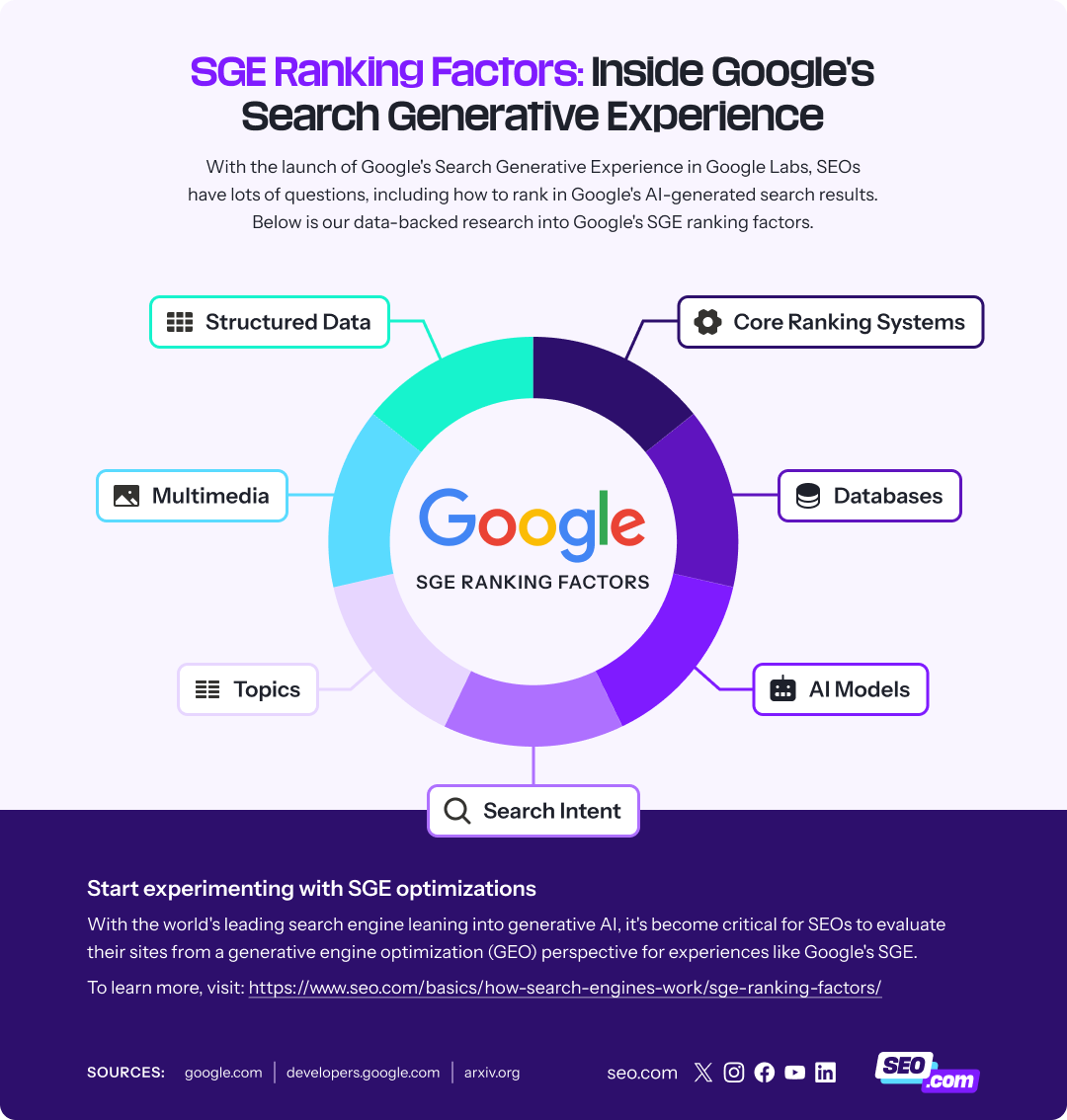Google’s Search Generative Experience (SGE) launched May 14, 2024 as AI Overviews, and has (as predicted) started to impact search engine optimization (SEO), which is why now is the time to develop a Google SGE strategy. Understanding how to rank in Google SGE effectively can help maintain your site’s visibility in this new search landscape.
Learn how to optimize for Google SGE with our proven approach!

Download the full Google SGE Factors infographic here
How to build a Google SGE strategy
Start building a Google SGE strategy for the company’s AI Overviews with these steps:
1. Determine your impact
First, understand how AI Overviews will affect your website. Several SEOs have developed processes (and templates) for this step, including Aleyda Solis. Your impact assessment will take time, as it requires manual searches.

Paid tools, like Semrush and ZipTie, offer rank tracking for AI Overviews
While completing an impact assessment for all URLs is possible, consider starting with URLs that rank on page one or two for their target keyword. You can use rank tracking tools to help identify these URLs.
If you have a larger site, focus on your most valuable pages for:
- Traffic
- Micro-conversions, like newsletter sign-ups
- Macro-conversions, like online sales or quote form submissions
Keep in mind that while the above template includes a column for the next steps to take, like page-specific optimizations, you do not have to complete that step as a part of your impact assessment. Instead, we’ll address that task later.
2. Audit your existing SEO
When it comes to SGE ranking factors, Google uses its core ranking systems from Google Search, making search engine optimization a non-negotiable part of AI Overview or Search Generative Experience strategies. Learning how to rank in Google SGE starts with a solid SEO foundation.
Conduct an SEO audit with a search engine optimization tool like Screaming Frog.
For websites with an SEO program in Poor health, focus on improving your SEO since SEO serves as the foundation to an effective SGE strategy.
Screaming Frog will highlight issues across SEO, from on-page to technical, and provide actionable advice on fixing errors related to crawling, indexing, internal linking, on-page optimizations, and more.
Your goal is to understand the overall health of your SEO program, like:
- Poor
- Good
- Excellent
For websites with an SEO program in Poor health, we recommend reconsidering AI Overview optimizations. Instead, focus on building and improving your search engine optimization strategy, which will serve as the foundation for ranking in SGE snapshots.
If your SEO program is in Good or Excellent health, now is the time to build a Google SGE strategy.
3. Evaluate your generative engine optimizations
When it comes to ranking in Google’s AI Overviews, SEOs use generative engine optimization (GEO), which includes tactics related to user experience (UX), search engine optimization, and design, like:
- Multimedia
- Structured data
- E-E-A-T
- Online mentions and/or reviews
Consider the following questions when evaluating a URL’s GEO:
- Does the content include custom multimedia, like graphics or video?
- Does the content use structured data, if applicable?
- Does the content demonstrate E-E-A-T?
On a sitewide scale, consider these questions:
- Does our brand have a Google Knowledge Panel?
- Does our brand use Google Merchant Center, if applicable?
- Is our brand featured on third-party websites, like directories?
Your answers will determine which optimizations get prioritized and implemented.
4. Outline your short- and long-term goals
Let’s recap. You now have answers to the following questions:
- How much will AI Overviews impact my site?
- How healthy is my site’s SEO?
- How well do I follow GEO best practices?
Now, it’s time to create some short- and long-term goals. These goals are useful for a few reasons:
- Demonstrating to leadership the team’s response
- Tracking the team’s push towards AI Overview rankings
- Understanding the effectiveness of these strategies
Focus on creating S.M.A.R.T. goals — Specific, Measurable, Achievable, Realistic, and Timely. While these goals can encompass multiple timelines, from weekly to monthly to quarterly, we recommend starting with monthly or quarterly goals.
5. Prioritize your optimizations
Next, prioritize which URLs and optimizations to focus on using data from the previous steps. We recommend focusing on URLs that rank on page one or two since these URLs have a better chance of appearing in AI Overviews.
For SGE optimizations, consider the following:
| Area | High impact | Medium impact | Low impact |
| Site-based |
|
|
|
| URL-based |
|
|
|
You can use additional prioritization methods, like ICE (Impact, Confidence, and Ease), to build an optimal Google SGE strategy for implementing these optimizations. For example, if an optimization requires more developer time at your organization, consider de-prioritizing it.
This step is where you can return to your impact assessment sheet and its next steps column.
6. Implement your optimizations
Work with your team (or SEO agency) to begin implementing the prioritized optimizations for AI Overviews. Document changes made, the date completed, and your before AI Overview rankings to provide the necessary data for a comprehensive before and after analysis.
Monitor AI Overview updates, too, as these updates could affect your placement.
7. Measure your AI Overview rankings
Changes in AI Overview rankings can take time — that’s why we recommend focusing your strategy on URLs ranking well in organic search results (preferably on page one). Typically, businesses will see ranking shifts within 30 days.
Keep in mind, though, that Google algorithm updates and AI Overview changes can affect this timeline. Just a few weeks after launch, Google was already pushing public updates for AI Overviews.
![]()
Because Google Search Console does not provide rank tracking for AI Overviews, measuring rankings is manual, though, some paid tools like Semrush and ZipTie offer AI Overview tracking.
If these tools are outside your budget, use a Google Sheet (similar to the impact assessment one shared earlier) to understand how SGE snapshots and your appearance in these AI Overviews has changed.
Check if your site appears in AI Overviews
Are you unsure if your website is appearing in AI Overviews? Our free AI Overview Checker will let you know! Not only that, it will display some crucial information for how organic results are informing the AI Overviews, and how your site can improve.
Rank in AI Overviews with an effective SGE strategy
You’ve got an effective SEO strategy. Now, level it up with a complementary SGE strategy. Understanding how to optimize for Google SGE and how to rank in Google SGE is crucial for maintaining visibility as these AI-powered features become more prominent. Build yours today, or get professional help with the above steps by contacting us online about our AI Overview optimization services!

Future-Proof Your SEO Strategy with OmniSEO™
Goodbye search engine optimization, hello search everywhere optimization.

FAQs
Learn more about AI Overviews and Search Generative Experience with these FAQs:
What is Search Generative Experience?
Search Generative Experience is an AI-powered snapshot (now called AI Overviews) that appears in Google Search. Users can access AI Overviews for free through Google Labs, though, AI Overviews is enabled for U.S. users logged into their Google account.
Why do AI Overviews matter?
AI Overviews matter because of their impact on organic search traffic. SEOs expect (and have seen) AI Overviews decrease organic visibility, traffic, and conversions, affecting businesses that use SEO to generate revenue.
What are the types of SGE snapshots?
There are three types of SGE (now AI Overview) snapshots:
- Collapsed: A snapshot is generated but requires users to click “Show more.”
- Opt-in: A snapshot is available but requires the user to click “Generate.”
- Absent: A snapshot is unavailable.
Within SGE snapshots, the content encompasses three categories (per Solis):
- Duplicate, which mimics the organic search results and is common for local searches.
- Summarize, which summarizes the organic search results but doesn’t meet the user’s intent.
- Accelerator, which summarizes the organic search results and meets the user’s intent.
What determines SGE rankings?
Based on our research, we’ve determined seven SGE ranking factors:
- AI models
- Core ranking systems
- Databases
- Topic
- Search intent
- Multimedia
- Structured data
For a quick summary, download our free infographic!


Future-Proof Your SEO Strategy with OmniSEO™
Goodbye search engine optimization, hello search everywhere optimization.
Table of Contents
- How to Build a Google SGE Strategy
- 1. Determine Your SGE Impact
- 2. Audit Your Existing SEO
- 3. Evaluate Your Generative Engine Optimizations
- 4. Outline Your Short- and Long-term Goals
- 5. Prioritize Your SGE Optimizations
- 6. Implement Your SGE Optimizations
- 7. Measure Your SGE Rankings
- Rank in SGE Snapshots with an Effective SGE Strategy
- FAQs

Future-Proof Your SEO Strategy with OmniSEO™
Goodbye search engine optimization, hello search everywhere optimization.
Writers

Free download: Google SGE Ranking Factors Guide





